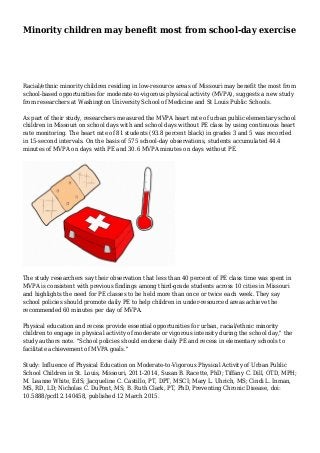
Minority children may benefit most from school-day exercise
- 1. Minority children may benefit most from school-day exercise Racial/ethnic minority children residing in low-resource areas of Missouri may benefit the most from school-based opportunities for moderate-to-vigorous physical activity (MVPA), suggests a new study from researchers at Washington University School of Medicine and St Louis Public Schools. As part of their study, researchers measured the MVPA heart rate of urban public elementary school children in Missouri on school days with and school days without PE class by using continuous heart rate monitoring. The heart rate of 81 students (93.8 percent black) in grades 3 and 5 was recorded in 15-second intervals. On the basis of 575 school-day observations, students accumulated 44.4 minutes of MVPA on days with PE and 30.6 MVPA minutes on days without PE. The study researchers say their observation that less than 40 percent of PE class time was spent in MVPA is consistent with previous findings among third-grade students across 10 cities in Missouri and highlights the need for PE classes to be held more than once or twice each week. They say school policies should promote daily PE to help children in under-resourced areas achieve the recommended 60 minutes per day of MVPA. Physical education and recess provide essential opportunities for urban, racial/ethnic minority children to engage in physical activity of moderate or vigorous intensity during the school day," the study authors note. "School policies should endorse daily PE and recess in elementary schools to facilitate achievement of MVPA goals." Study: Influence of Physical Education on Moderate-to-Vigorous Physical Activity of Urban Public School Children in St. Louis, Missouri, 2011-2014, Susan B. Racette, PhD; Tiffany C. Dill, OTD, MPH; M. Leanne White, EdS; Jacqueline C. Castillo, PT, DPT, MSCI; Mary L. Uhrich, MS; Cindi L. Inman, MS, RD, LD; Nicholas C. DuPont, MS; B. Ruth Clark, PT, PhD, Preventing Chronic Disease, doi: 10.5888/pcd12.140458, published 12 March 2015.